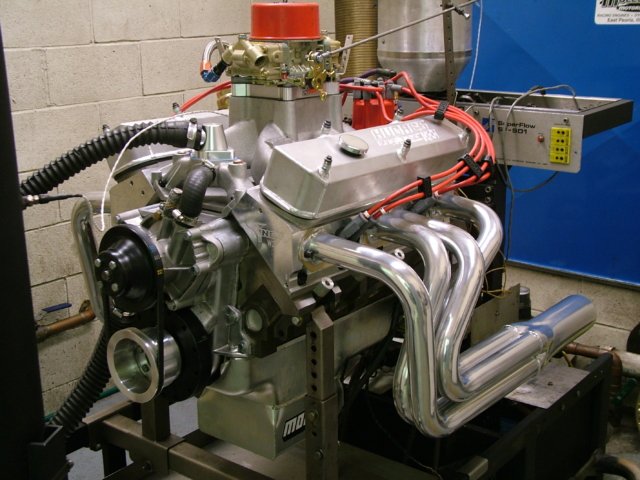
Aside from being a top-shelf supplier of performance parts for Mopar applications, Hughes Engines is an absolute treasure trove of knowledge on how to squeeze every last pony out of your small block, big block, or modern Mopar engine. Their technical article index is chock full of information including this great little snippet answering the age old question of single plane versus dual plane intakes:
A single plane intake will flow more air than a dual plane intake for the same engine! Does that make it better? In about 90% of the cases, that’s a big no good, buddy! In fact, in 90% of the cases, a dual plane intake will outperform a single plane. Some years ago, we did a dyno test of a small block Mopar 408” (see our dyno test #19). This engine produced 630 horsepower with a single plane intake and 580 horsepower with a dual plane.

However, the dual plane was within single digits of horsepower and torque up to 5,500 RPM. And, at 4,000 RPM, the dual plane was 60 hp and 80 ft.-lbs. of torque better. The single plane was only stronger from 5,600 RPM to 6,800 RPM. So, unless you had a 4-speed or a 5,000+ RPM stall speed and drove with your foot on the floor, the dual plane would dominate, especially on the street when you nailed the throttle anywhere near 4,000 RPM – hang on!
If you want to brag about your maximum horsepower, use a single plane. If you want to drive your car and enjoy it, use a dual plane. This is another one of those trade-offs you must deal with when building an engine. As a side note, there are ways to make a dual plane intake act more like a single plane intake – in other words move the power range to a higher RPM level – with some mid-range power traded off. But there are no ways to make a single plane act more like a dual plane.

So does this mean that the flow bench lies when it says the single plane flows more? No, what it means is that flow numbers alone don’t tell you the whole story; it’s the combination of parts and, just like any powerful sports team, the keyword is TEAM! What this tells you is to pick a combination that meets your needs, not some pie-in-the-sky dream engine that is a nightmare to drive or because some “chatter” on the internet says it will work.
Now, the next question to be asked and answered is, “How are you going to use your engine?” If it is on the street up to 70% of the time, the dual plane will be your best choice. If it is 50/50 street/strip, you have a tough decision and know that neither manifold is perfect for a 50/50 engine. If it is a 4-speed and you are going to be shifting at 6,500 RPM+ or you have a high stall automatic (3,800/4,000 RPM), the single plane would be your best choice. And get a trailer! You will probably need it.








Would enjoy having Hughes run tests with an STR-12 cross ram (which I have unused, never bolted on) on a 340 for the street. Using a nice cam, 650 Holleys or ?, 340 X heads based on running 3.55 rear gears and a 4 speed and 60’s series 14″ tires. Opinions are all over the place but hard copy facts are nowhere to be found. I know these are frail when cold, again by the number of cracked ones people tell me about.
Those 14’s are doing you a disservice.
Ok. Im gonna ask a age ol question that never seems to get answered…… ls anyone out there looking to make an aftermarket la block that can take big power such as dart? At reasonable price?
Please dont tell me that there is no market for it since edelbrock afr etc .etc . Have no issue making go fast pieces for the LA. Plenty of market for parts to make the small block mopar produce serious power and i doubt they would go to the trouble if demand wasnt there.
Well I hate to say it but there is no market for it, I know Dart and KB have looked seriously at doing SBM blocks, the market is just not there , Call Ritter and ask them how many blocks they have sold. it took Moperformance how long to sell off the Supply of R3 blocks.
What about the NASCAR RP7 blocks? If you look around you can usually find them for a reasonable price.
It all depends on what you think a reasonable price is. The Mopar market is limited due to very low sales compared to Chevy ,GM, Ford ect. Very hard to justify laying out millions to develop something that is going to have a very low sales figure. This is the only aftermarket available Chrysler LA block today and I guarantee you Kent Ritter is barely making any money on this at this price. He has done this project because it is a labor of love for him and it has not been an easy process for him. https://www.racingjunk.com/Blocks/183988964/Ritter-Racing-Block-Small-Block-Mopar.htmll
It all depends on what you think a reasonable price is. The Mopar market is limited due to very low sales compared to Chevy ,GM, Ford ect. Very hard to justify laying out millions to develop something that is going to have a very low sales figure. This is the only aftermarket available Chrysler LA block today and I guarantee you Kent Ritter is barely making any money on this at this price. He has done this project because it is a labor of love for him and it has not been an easy process. ps://www.racingjunk.com/Blocks/183988964/Ritter-Racing-Block-Small-Block-Mopar.htmll
As a mostly G.M. guy i decided to go dark and buy a 69 barracuda. It came with a good 360 magnum engine and i thought this will be fun since it has a roller cam in these days of crap oils for simple (cheap) cams . So i try to find parts for it and make a 4 speed just for fun. Well not so fun time with that one and now i am going big block instead. I tried but failed to make a nice driving small block car but there really is not much out there for that engine that was produced in large numbers in pick me ups. Kind of sad but it is my discovered truth about this great engine for a street toy. Small block Chevy for parts availability it is not. Then i started to do research on a big block Ford for my other project the mufftang and all i find is small block stuff. live and learn the hard truths, right.